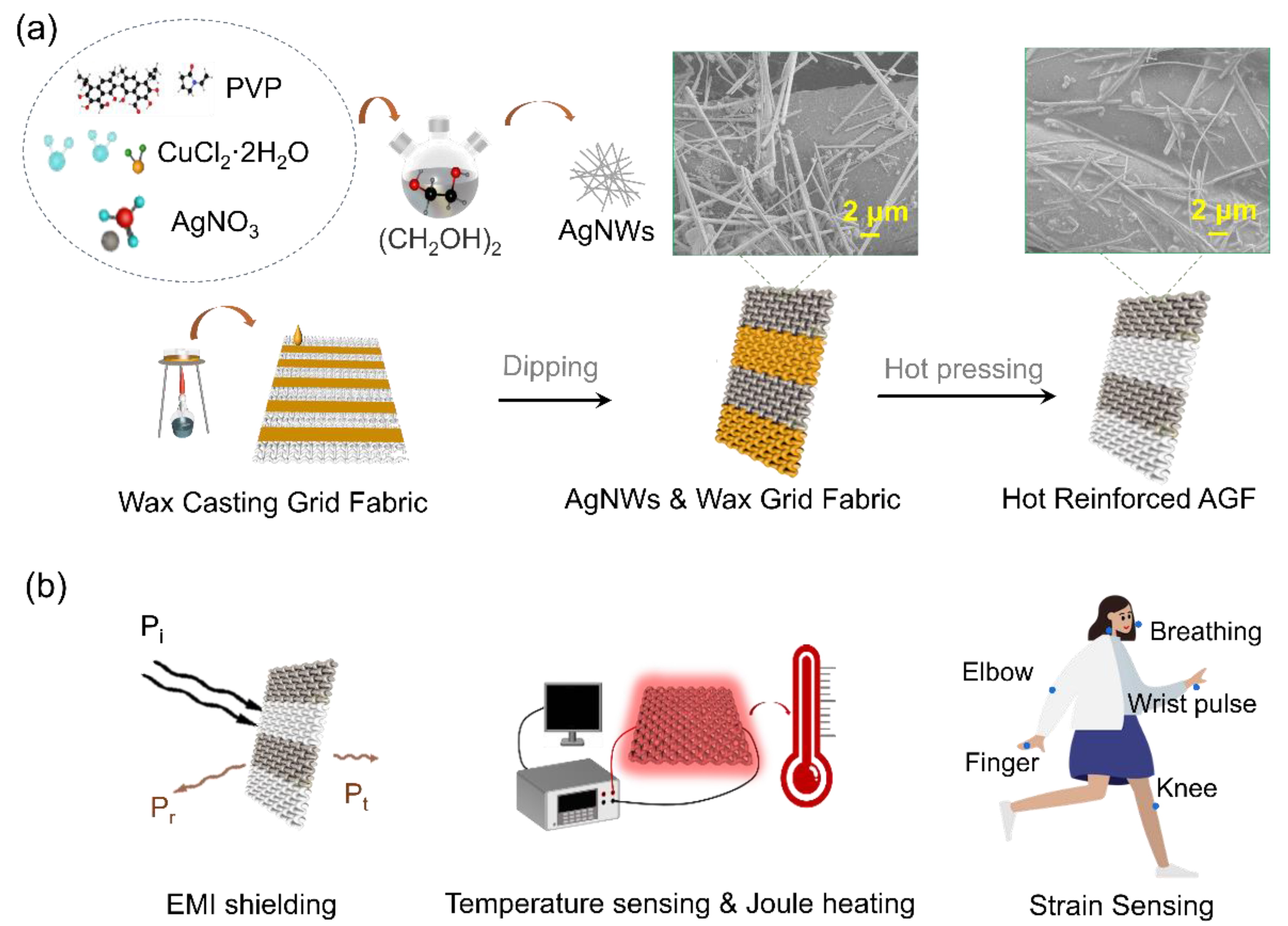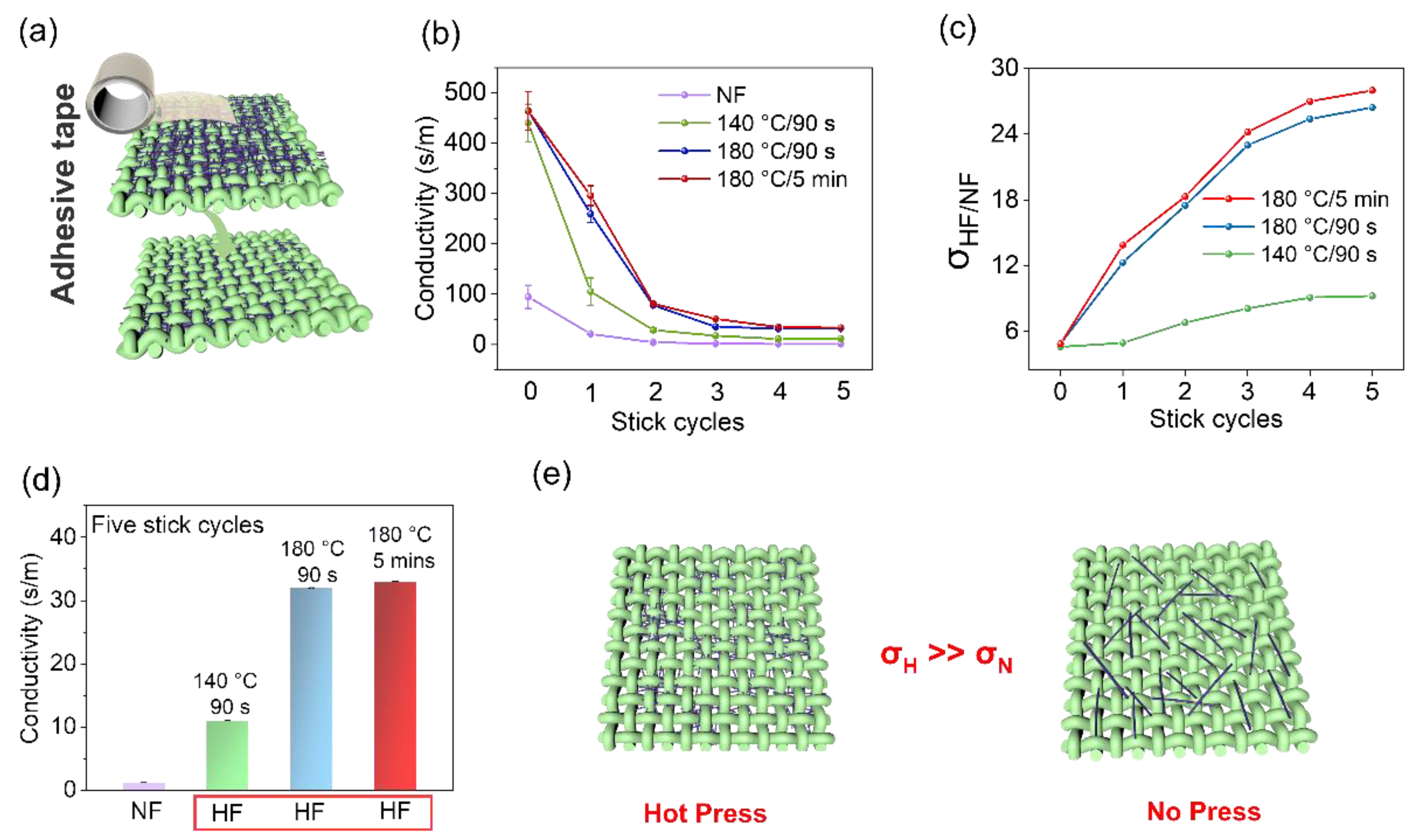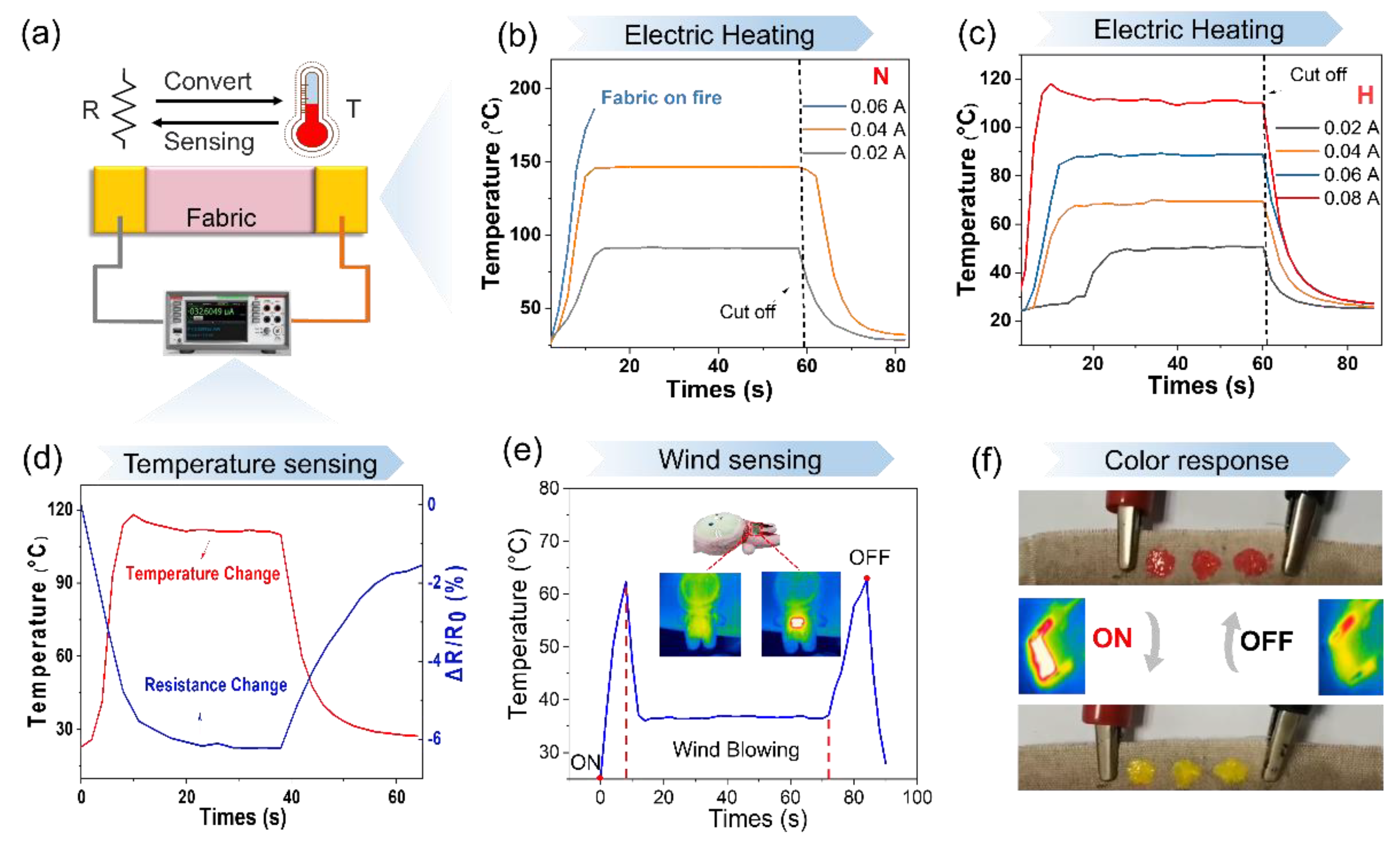Multifunctional Silver Nanowire Fabric Reinforced by Hot Pressing for Electromagnetic Interference Shielding, Electric Heating, and Sensing
Abstract
:1. Introduction
2. Experimental
2.1. Materials
2.2. Fabrication of AgNWs/PET Fabric
2.3. Characterizations
3. Results and Discussion
3.1. Conductivity and Electromagnetic Shielding
3.2. Stick-Resistant Peeling Performance
3.3. Water Washing Fastness
3.4. Strain Sensing Performance
3.5. Electrical Heating and Temperature Sensing Performances
4. Conclusions
Author Contributions
Funding
Institutional Review Board Statement
Data Availability Statement
Conflicts of Interest
References
- Zhao, X.; Wang, L.Y.; Tang, C.Y.; Zha, X.J.; Liu, Y.; Su, B.H.; Ke, K.; Bao, R.Y.; Yang, M.B.; Yang, W. Smart Ti3C2Tx MXene Fabric with Fast Humidity Response and Joule Heating for Healthcare and Medical Therapy Applications. ACS Nano 2020, 14, 8793–8805. [Google Scholar] [CrossRef] [PubMed]
- Ahmed, U.; Hussain, T.; Ahmad, H.S. Novel knitted fabric structures for shielding against electromagnetic and thermal radiation from laptops and mobile phones. Int. J. Therm. Sci. 2023, 194, 108594. [Google Scholar] [CrossRef]
- Ma, J.; Zhao, Q.; Zhou, Y.; He, P.; Pu, H.; Song, B.; Pan, S.; Wang, Y.; Wang, C. Hydrophobic wrapped carbon nanotubes coated cotton fabric for electrical heating and electromagnetic interference shielding. Polym. Test. 2021, 100, 107240. [Google Scholar] [CrossRef]
- Huang, L.Z.; Yuan, Q.; Ji, X.X.; Li, D.D.; Zhang, W.; Guo, W.Y.; Qi, M.Y.; Ma, M.G. Multifunctional MXene-decorated cotton fabric with diferent weaves, outstanding photothermal efect, and rapid response. Cellulose 2022, 29, 6997–7010. [Google Scholar] [CrossRef]
- Wang, L.; Zhang, M.; Yang, B.; Tan, J. Lightweight, Robust, Conductive Composite Fibers Based on MXene@Aramid Nanofibers as Sensors for Smart Fabrics. ACS Appl. Mater. Interfaces 2021, 13, 41933–41945. [Google Scholar] [CrossRef]
- Liu, X.Y.; Jin, X.; Li, L.; Wang, J.F.; Yang, Y.Y.; Cao, Y.X.; Wang, W.J. Air-permeable, multifunctional, dual-energy-driven MXene-decorated polymeric textile-based wearable heaters with exceptional electrothermal and photothermal conversion performance. J. Mater. Chem. A 2020, 8, 12526–12537. [Google Scholar] [CrossRef]
- Wang, C.X.; Lv, J.C.; Ren, Y.; Zhi, T.; Chen, J.Y.; Zhou, Q.Q.; Lu, Z.Q.; Gao, D.W.; Jin, L.M. Surface modification of polyester fabric with plasma pretreatment and carbon nanotube coating for antistatic property improvement. Appl. Surf. Sci. 2015, 359, 196–203. [Google Scholar] [CrossRef]
- Kumagai, S.; Hirahashi, S.; Grause, G.; Kameda, T.; Toyoda, H.; Yoshioka, T. Alkaline hydrolysis of PVC-coated PET fibers for simultaneous recycling of PET and PVC. J. Mater. Cycles Waste Manag. 2017, 20, 439–449. [Google Scholar] [CrossRef]
- Cheng, T.; Zhang, Y.Z.; Lai, W.Y.; Chen, Y.; Zeng, W.J.; Huang, W. High-performance stretchable transparent electrodes based on silver nanowires synthesized via an eco-friendly halogen-free method. J. Mater. Chem. C 2014, 2, 10369–10376. [Google Scholar] [CrossRef]
- Ye, S.; Rathmell, A.R.; Chen, Z.; Stewart, I.E.; Wiley, B.J. Metal nanowire networks: The next generation of transparent conductors. Adv. Mater. 2014, 26, 6670–6687. [Google Scholar] [CrossRef]
- Ma, J.; Zhan, M.; Wang, K. Ultralightweight silver nanowires hybrid polyimide composite foams for high-performance electromagnetic interference shielding. ACS Appl. Mater. Interfaces 2015, 7, 563–576. [Google Scholar] [CrossRef] [PubMed]
- Xie, H.; Yang, X.; Du, D.; Zhao, Y.; Wang, Y. Flexible Transparent Conductive Film Based on Random Networks of Silver Nanowires. Micromachines 2018, 9, 295. [Google Scholar] [CrossRef] [PubMed]
- Sun, W.H.; Hung, D.S.; Song, T.T.; Lee, S.F. The Characterization of Microwave Properties of PU-AgNWs Films. Ferroelectrics 2012, 435, 148–154. [Google Scholar] [CrossRef]
- Gorji, M.; Mazinani, S.; Faramarzi, A.R.; Ghadimi, S.; Kalaee, M.; Sadeghianmaryan, A.; Wilson, L.D. Coating Cellulosic Material with Ag Nanowires to Fabricate Wearable IR-Reflective Device for Personal Thermal Management: The Role of Coating Method and Loading Level. Molecules 2021, 26, 3570. [Google Scholar] [CrossRef] [PubMed]
- Tibayan, E.B., Jr.; Muflikhun, M.A.; Kumar, V.; Fisher, C.; Al Rey, C.V.; Santos, G.N.C. Performance evaluation of Ag/SnO2 nanocomposite materials as coating material with high capability on antibacterial activity. Ain Shams Eng. J. 2020, 11, 767–776. [Google Scholar] [CrossRef]
- Wang, C.X.; Ren, Y.; Lv, J.C.; Zhou, Q.Q.; Ma, Z.P.; Qi, Z.M.; Chen, J.Y.; Liu, G.L.; Gao, D.W.; Lu, Z.Q.; et al. In situ synthesis of silver nanoparticles on the cotton fabrics modified by plasma induced vapor phase graft polymerization of acrylic acid for durable multifunction. Appl. Surf. Sci. 2017, 396, 1840–1848. [Google Scholar] [CrossRef]
- Liu, G.S.; Xu, Y.; Kong, Y.; Wang, L.; Wang, J.; Xie, X.; Luo, Y.; Yang, B.R. Comprehensive Stability Improvement of Silver Nanowire Networks via Self-Assembled Mercapto Inhibitors. ACS Appl. Mater. Interfaces 2018, 10, 37699–37708. [Google Scholar] [CrossRef]
- Zhou, K.; Zhao, Y.; Sun, X.; Yuan, Z.; Zheng, G.; Dai, K.; Mi, L.; Pan, C.; Liu, C.; Shen, C. Ultra-stretchable triboelectric nanogenerator as high-sensitive and self-powered electronic skins for energy harvesting and tactile sensing. Nano Energy 2020, 70, 104546. [Google Scholar] [CrossRef]
- Li, Z.B.; Li, H.Y.; Fan, Y.J.; Liu, L.; Chen, Y.H.; Zhang, C.; Zhu, G. Small-Sized, Lightweight, and Flexible Triboelectric Nanogenerator Enhanced by PTFE/PDMS Nanocomposite Electret. ACS Appl. Mater. Interfaces 2019, 11, 20370–20377. [Google Scholar] [CrossRef]
- Zhao, W.; Zheng, Y.; Qian, J.; Zhaofa, Z.; Jin, Z.; Qiu, H.; Zhu, C.; Hong, X. AgNWs/MXene derived multifunctional knitted fabric capable of high electrothermal conversion efficiency, large strain and temperature sensing, and EMI shielding. J. Alloys Compd. 2022, 923, 166471. [Google Scholar] [CrossRef]
- Hong, X.; Zhao, W.; Yu, R.; Wang, Q.; Zeng, F.; Tao, Y.; Jin, Z.; Zhu, C. Multifunctional silver nanowire coated fabric capable of electrothermal, resistance temperature-sensitivity, electromagnetic interference shielding, and strain sensing. J. Industial Text. 2022, 51 (Suppl. S4), 6153S–6172S. [Google Scholar] [CrossRef]
- Chaccour, K.C.; Darazi, R.; El Hassani, A.H.; Andres, E. Smart Carpet using differential piezoresistive pressure sensors for elderly fall detection. In Proceedings of the 2015 IEEE 11th International Conference on Wireless and Mobile Computing, Networking and Communications (WiMob), Abu Dhabi, United Arab Emirates, 19–21 October 2015. [Google Scholar] [CrossRef]
- Bao, B.; Rivkin, B.; Akbar, F.; Karnaushenko, D.D.; Bandari, V.K.; Teuerle, L.; Becker, C.; Baunack, S.; Karnaushenko, D.; Schmidt, O.G. Digital electrochemistry for on-chip heterogeneous material integration. Adv. Mater. 2021, 33, 2101272. [Google Scholar] [CrossRef]
- Nawaz, A.; Merces, L.; Ferro, L.M.; Sonar, P.; Bufon, C.C. Impact of Planar and Vertical Organic Field-Effect Transistors on Flexible Electronics. Adv. Mater. 2023, 35, 2204804. [Google Scholar] [CrossRef]






Disclaimer/Publisher’s Note: The statements, opinions and data contained in all publications are solely those of the individual author(s) and contributor(s) and not of MDPI and/or the editor(s). MDPI and/or the editor(s) disclaim responsibility for any injury to people or property resulting from any ideas, methods, instructions or products referred to in the content. |
© 2023 by the authors. Licensee MDPI, Basel, Switzerland. This article is an open access article distributed under the terms and conditions of the Creative Commons Attribution (CC BY) license (https://creativecommons.org/licenses/by/4.0/).
Share and Cite
Zeng, F.; Zheng, Y.; Wei, Y.; Li, H.; Wang, Q.; Shi, J.; Wang, Y.; Hong, X. Multifunctional Silver Nanowire Fabric Reinforced by Hot Pressing for Electromagnetic Interference Shielding, Electric Heating, and Sensing. Polymers 2023, 15, 4258. https://doi.org/10.3390/polym15214258
Zeng F, Zheng Y, Wei Y, Li H, Wang Q, Shi J, Wang Y, Hong X. Multifunctional Silver Nanowire Fabric Reinforced by Hot Pressing for Electromagnetic Interference Shielding, Electric Heating, and Sensing. Polymers. 2023; 15(21):4258. https://doi.org/10.3390/polym15214258
Chicago/Turabian StyleZeng, Fangmeng, Yiqian Zheng, Yuxin Wei, Han Li, Qicai Wang, Jian Shi, Yong Wang, and Xinghua Hong. 2023. "Multifunctional Silver Nanowire Fabric Reinforced by Hot Pressing for Electromagnetic Interference Shielding, Electric Heating, and Sensing" Polymers 15, no. 21: 4258. https://doi.org/10.3390/polym15214258
APA StyleZeng, F., Zheng, Y., Wei, Y., Li, H., Wang, Q., Shi, J., Wang, Y., & Hong, X. (2023). Multifunctional Silver Nanowire Fabric Reinforced by Hot Pressing for Electromagnetic Interference Shielding, Electric Heating, and Sensing. Polymers, 15(21), 4258. https://doi.org/10.3390/polym15214258





